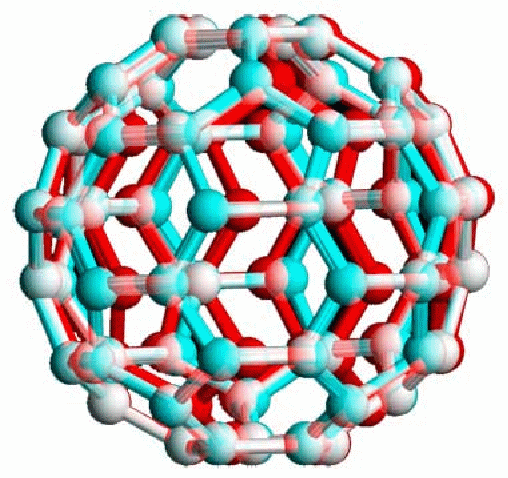Buckminster Fullerene,![]() is a strange form of molecular carbon, remarkably like a sphere, or more accurately a football, because the molecules may be pictured to be at the vertices of the faces of the football.
is a strange form of molecular carbon, remarkably like a sphere, or more accurately a football, because the molecules may be pictured to be at the vertices of the faces of the football.

A common method used to produce fullerenes is to send a large current between two graphite electrodes in an inert atmosphere. The resulting carbon plasma arc between the electrodes cools into sooty residue in which buckminster fullerene molecules may be found.
![]() may be used as a lubricant. They have been proposed for use in drug delivery.
may be used as a lubricant. They have been proposed for use in drug delivery.
The![]() molecule can also absorb large numbers of hydrogen atoms - almost one hydrogen for each carbon - without disrupting the buckyball structure. This property suggests that
molecule can also absorb large numbers of hydrogen atoms - almost one hydrogen for each carbon - without disrupting the buckyball structure. This property suggests that![]() may be a better storage medium for hydrogen than metal hydrides which is known as the best current material, and hence possibly a key factor in the development of a new class battery and even of non-polluting automobiles based on fuel cells, lighter and more efficient than lead-acid batteries.
may be a better storage medium for hydrogen than metal hydrides which is known as the best current material, and hence possibly a key factor in the development of a new class battery and even of non-polluting automobiles based on fuel cells, lighter and more efficient than lead-acid batteries.
Solids based on buckyballs can be insulators, conductors, semiconductors, or even superconductors when doped with other atoms or molecules. Pure buckyball solids form crystal structures, like graphite or diamond that are insulators or semiconductors. However, when doped with an alkali metal, such rubidium, these solids can become electricity-conducting metals. Furthermore, when a fullerene is "doped" by inserting just the right amount of potassium into empty spaces within the crystal, it becomes a superconductor--the best organic superconductor known. (But if greater amounts of potassium are used in the doping reaction, the resultant crystal becomes an insulator.)
![]() is able to withstand high temperatures and pressures to, like diamond and carbon.
is able to withstand high temperatures and pressures to, like diamond and carbon.